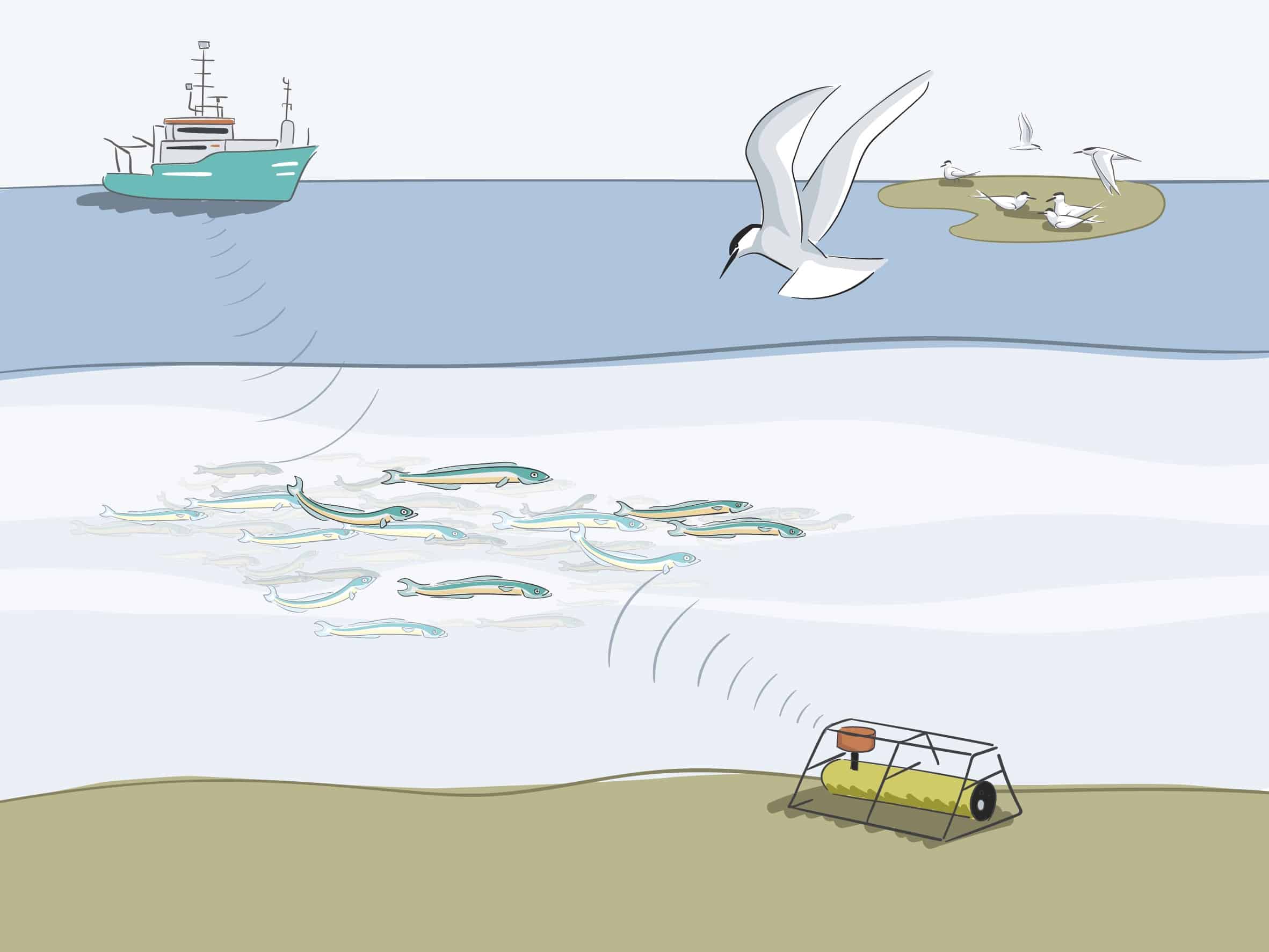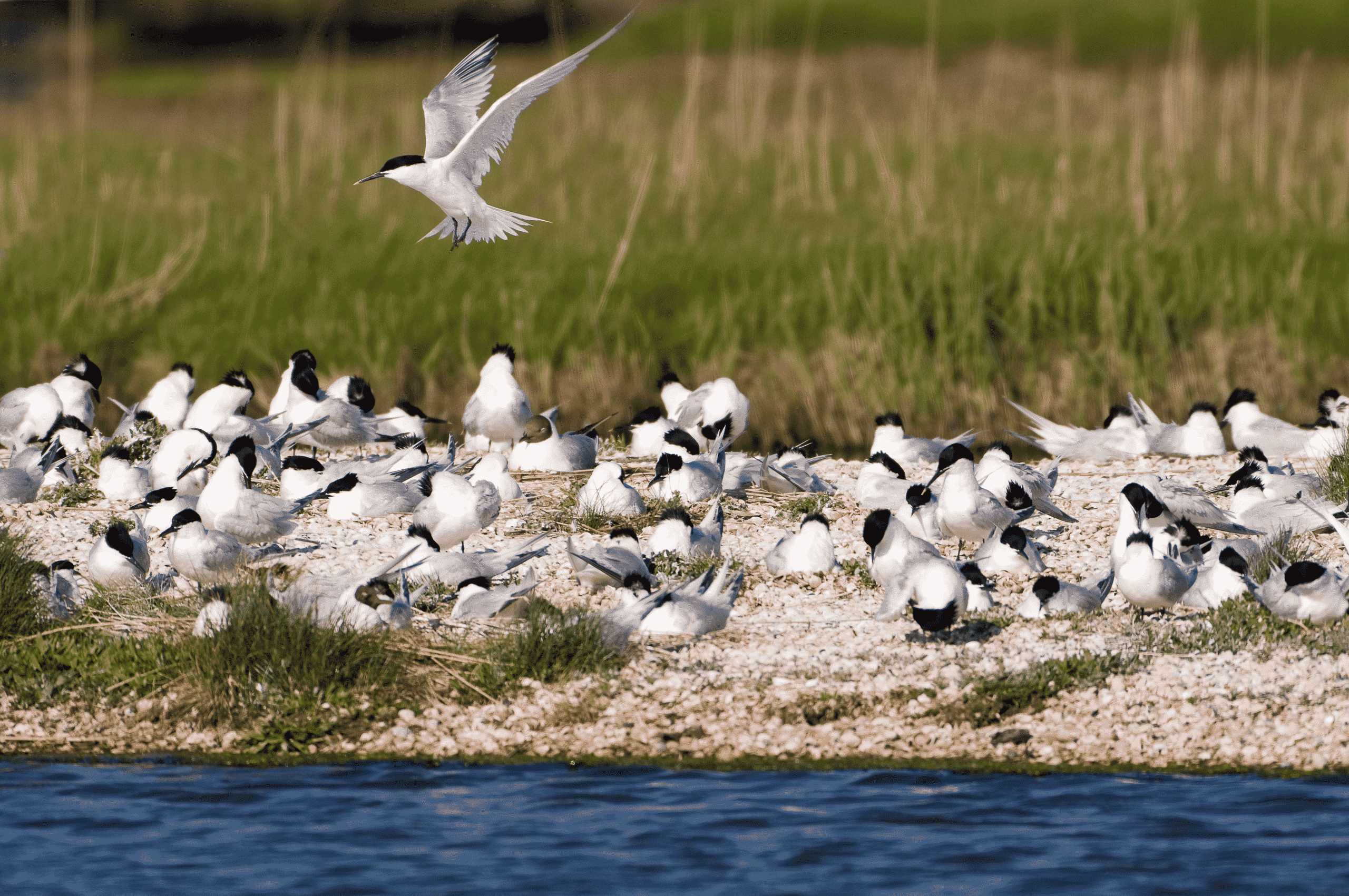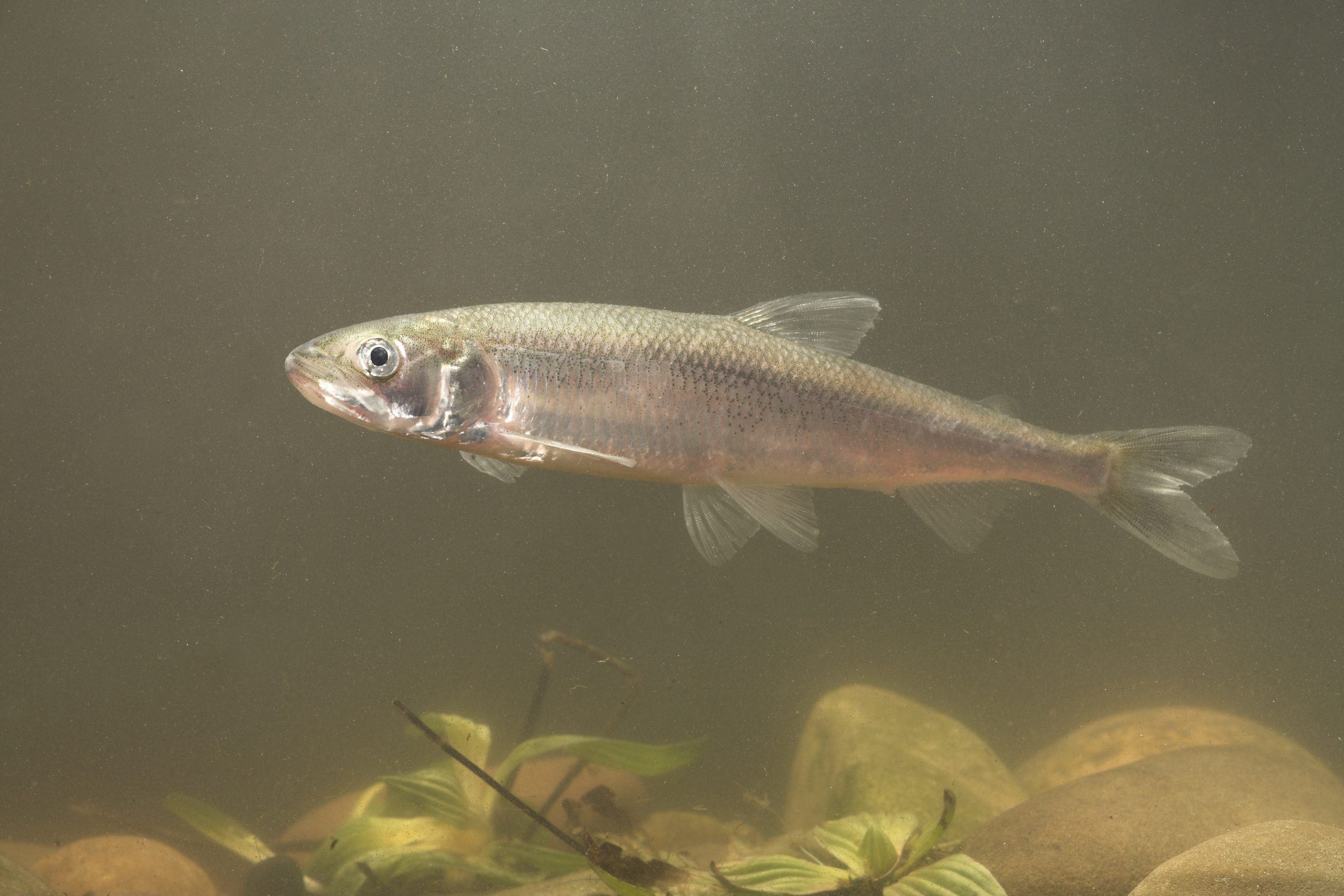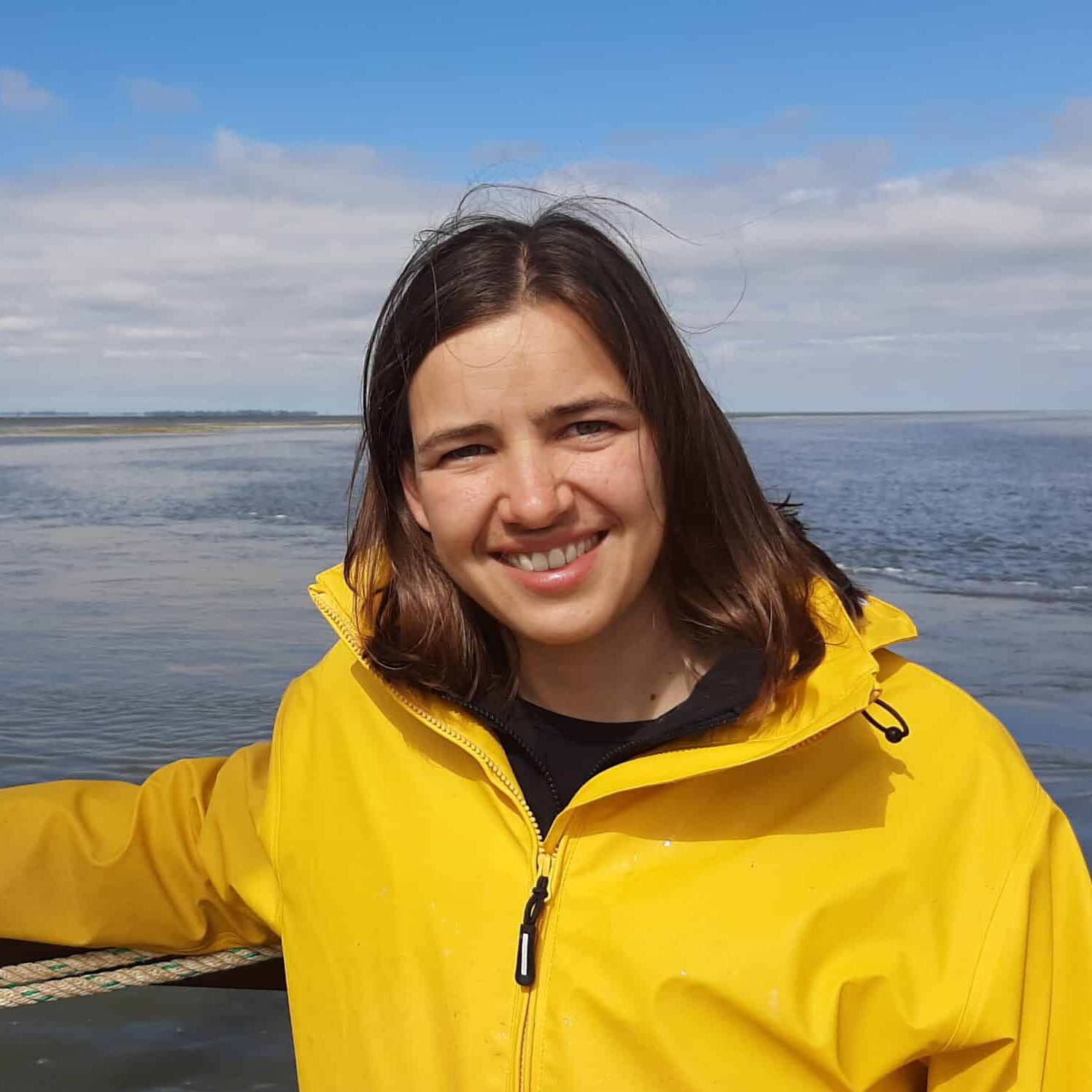IN WHAT WAYS IS THE WADDEN SEA IMPORTANT FOR SMALL PELAGIC FISH?
This sub-project focuses on small pelagic fish. In contrast to fish species that live on or just above the sea floor, these fish swim in the water column, often in schools. Pelagic, or school-forming fish species found in the Wadden Sea include sand eel, herring and sprat. These are food for fish-eating birds such as terns and gulls, but also for seals. The pelagic species together probably represent a far larger part of the total fish biomass present in the area than the benthic fish.

Pelagic fish are monitored from a boat using acoustic ‘fish profilers’ and sonar equipment. The results will also reveal whether the breeding islands for terns – which feed their young on these fish – are in a favourable location.
Role of the Wadden Sea
Pelagic fish are highly mobile. Their location is mainly determined by abiotic factors (temperature, salinity) and seasonal dynamics. As a result, there is usually strong variation between years and seasons. We still lack fundamental knowledge about the processes that determine the occurrence and distribution of these fish in shallow waters such as the Wadden Sea. The aim is to get a better idea of how these fish use the Wadden Sea: do quantities and species composition differ between different basins? And throughout the year? How do they use the area? Mainly for feeding, or also for spawning? How does their behaviour vary during the day (for example, they are only available to terns when they are at the surface)? These findings will result in a better understanding of how the Wadden Sea system works for pelagic fish, and of the availability of food for seabirds and seals.
Fish-eating birds
Pelagic fish species are often on the menu of fish-eating birds such as terns and gulls. Some bird species that nest in the Wadden Sea region are strongly dependent on pelagic fish to raise their young. They feed small fish to their young, and carry them one by one from the sea to the colony. This means that there must be enough fish of the right size and species not too far from a breeding colony. Terns, for example, can only reach fish in the uppermost half metre of the water column, and the water must be clear enough to see them from the air (but not so clear that the fish can detect the birds). In cooperation with the research programme Us & Wadden Birds, we are studying the importance of the proximity of pelagic fish for the breeding success of these birds. The knowledge gained from the Swimway study about the occurrence of pelagic fish will contribute to assessing the likely effects of constructing breeding islands for fish-eating birds.
Transition from salt to fresh water
Some pelagic fish such as smelt need both fresh and salt water during their life cycle. They migrate upstream to spawn in the upper reaches of rivers and the young fish migrate back to the sea. Natural transitions between salt and fresh water are scarce and there are many obstacles for migrating fish. The largest obstacle in the Wadden Sea is the Afsluitdijk. Fresh water is discharged in a controlled manner into the Wadden Sea near the Kornwerderzand sluices. Fish are attracted to fresh water and therefore it is expected that the discharge regime (when and how much water is discharged) influences the occurrence of fish in the sluice area. This will be further investigated in this project, and the results can be used to optimise discharge management.
HOW WILL WE INVESTIGATE THIS?
The research is carried out in different subareas (basins) of the Wadden Sea that are fed by tidal inlets and separated where tidal currents of two adjoining basins meet. Each basin has an entrance and exit where seawater flows in and out of the Wadden Sea with the tide, and these tidal inlets separate the Wadden Islands from each other.
Tracking movements of small pelagic fish
The movements of schools of small pelagic fish through the channels in and out of the North Sea will be studied using a moored echosounder on the seafloor, the (WBAT) Autonomous scientific echo sounder system. The researchers use this to register the presence and movement of fish in the water column above the device. Through echolocation they collect information about the size of the shoals, and timing and depth of fish movements. Observations will be made over a period of three years to monitor any differences between years and seasons.
Studying fish species
The echosounder registers fish schools but echolocation cannot distinguish between the different species. In order to find out more, additional anchorage sampling is done in the tidal inlets and gullies. To do this an anchored ship samples the tidal current with a large net. This data collection will be done once a month for a year, thus mapping seasonal changes in abundance, species composition and also yielding important information on fish condition, a relevant parameter in terms of food for bird chicks.
At all sites, the presence of zooplankton, the food for pelagic fish, is also recorded. We analyse the stomach contents and otoliths of the fish that are caught and determine their spawning stage. This provides information about their age, use of the area, food relationships, growth and living conditions, and potential use of the Wadden Sea as a spawning ground.
Measuring fish numbers
In order to get a picture of the total amount of pelagic fish, for example as food for fish-eaters (birds and mammals), the density of the schools of fish will be mapped using an echosounder on a research vessel on several occasions. This gives an indication of the total biomass present. We also sample the shoals, so that we know which species are represented in the acoustic images. This research will take place in spring and autumn over a period of two years, so that we can track seasonal and yearly variation.
Relationship between sluice regime and pelagic fish
Fish trying to cross the Afsluitdijk can now only do so at Kornwerderzand and Den Oever. The only way they can get into the IJsselmeer lake is when fresh water is discharged from the IJsselmeer into the Wadden Sea. Fish are attracted by the freshwater discharge. We will study the extent to which fish movement towards the freshwater plume is related to the discharge regime, and how the regime can be further optimised so that fish can enter the IJsselmeer more easily. For this we are using model data on salinity levels and fish monitoring data that has been collected in the Kornwerderzand sluiceway since 2000.


Who?
Research institute: Wageningen Marine Research
PhD Researcher: Margot Maathuis





